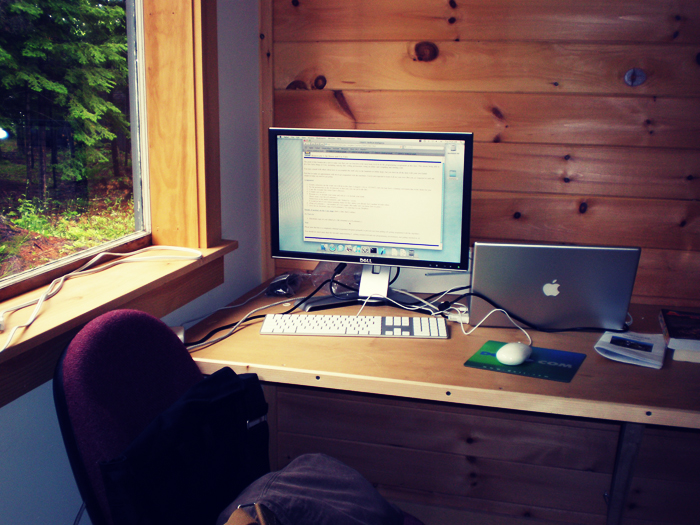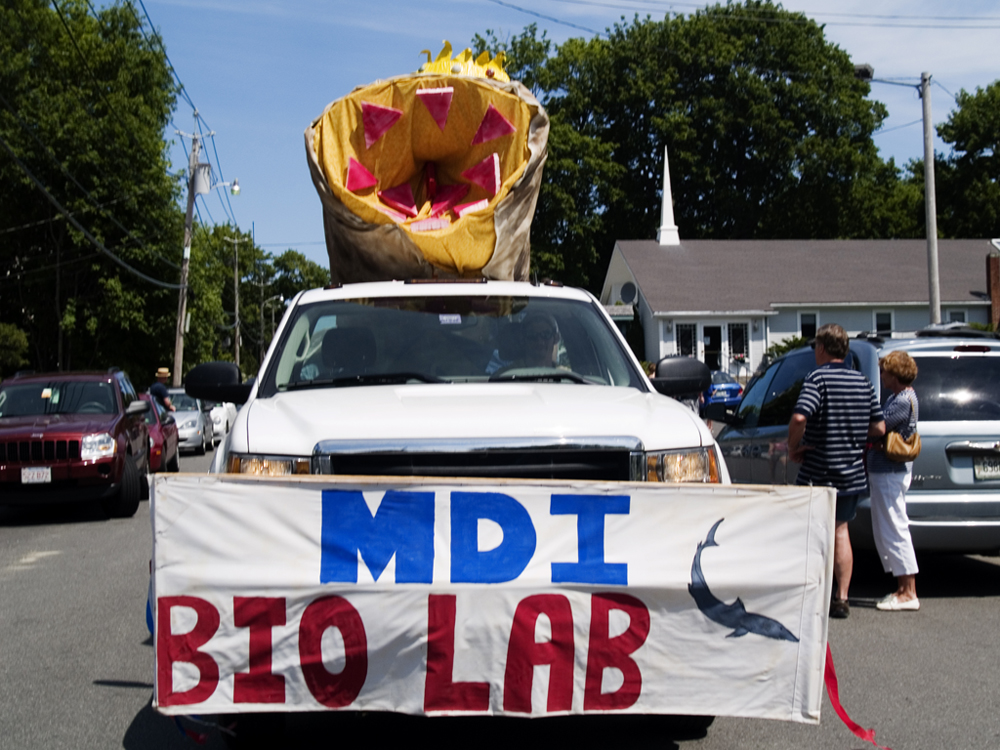week 1.
Monday:
I arrive at Bar Harbor airport, and Clare drives me back to MDIBL (Mount Desert Island Biological Laboratory). After lunch at the MDIBL Co-op, we sign in and head out to hunt down our lab.

Yup, that's the lab. It looks more like a shed of some sort more than anything else, but fortunately, the insides are in much better condition.

I've just completed a class in C++, but I've never learnt C, so today, I'm reading a C textbook and making a list of the major differences between C and C++.
Tuesday:
Clare gives me a website with some C exercises that she uses on her students and I spend the rest of the day working on them.
Wednesday:
I've finished the C exercises, so I spend the day looking at some slides for a presentation Clare did on Genetic Algorithms and poking around with Genesis.
During lunch, we listen to a talk on thermal regulation in lobsters and crabs. Most of it is beyond me, but I do learn that lobsters adapt to drastic temperature changes much more quickly than crabs do. Also, the reason there are more lobsters during certain seasons seems to be due more to the fact that fishermen prefer to do their lobster-catching in better weather.
Thursday:
I spend the morning poking around more with Genesis, and the afternoon wading through a Bioinformatics text. I make the most of the sun’s brief appearance and take the textbook outside, where there’s an amazing view of the ocean.

Friday:
Pretty much the same as Thursday, only with a different Bioinformatics text.
week 2.
Monday:
We attend a talk by Dr. Bruce Stantom of Dartmouth Medical School in the morning. The name of the talk is Serum and Glucocorticoid Inducible Kinase and Acute Adaptation to Seawater in Fundulus heteroclitus, which roughly translates to a study of the impact of SKG on CFTR in killifish. Unfortunately, most of it went over my head. In the afternoon, I had a discussion with Junes (another student working with Clare this summer) about possible presentation topics for GECCO.
Tuesday:
Clare sends us copies of the GAMI (Genetic Algorithms for Motif Inference) code which we will be working with, and I spend the day poking away at it. Previously, Genesis came with a default function which tried to optimize the sum of squares using random numbers, but Clare provides us with 2000 bases upstream of the CFTR gene this time.
Wednesday & Thursday:
GAMI runs some experiments in the background while I work on explaining what GAMI is.
Friday:
I spend the morning poking around Ensembl and we have a discussion about the projects we are to present at GECCO, which is in two weeks. *gasp* Clare sends me some data that I might be working on for the rest of the summer.
week 3.
Monday:
I ran some experiments using ABCB and ABCC data. While experiments were running, I do some research into what ABCB and ABCC actually means.
Tuesday:
I somehow managed to mix up the files for GAMI and its post-processor, so I try and sort things out and figure out how to make the post-processor do what I want it to.
Wednesday:
Started preliminary experiments using CFTR data. It takes about an hour for each trial given the default parameters.
Thursday:
Received a crash course in “ssh” and “sftp” and a little bit of emacs, and started running the “real” experiments.
Friday:
Fourth of July! Took part in the parade at Bar Harbor as part of the Mount Desert Island Bio Lab float, which had the theme “Salute to Lamprey-ty”. The original theme was “Salute to Liberty”. Also continued running more “real” experiments.

week 4.
Monday & Tuesday:
Worked on the Powerpoint and my script for the presentation at GECCO. Also did some analysis of the results from GAMI experiments on four parameters: crossover, mutation, directed mutation, slide mutation.
Wednesday:
Finalized the Powerpoint and analyzed motifs found by GAMI for conserved location.
Thursday:
I spend the morning polishing off the poster for the GECCO poster session and spend the rest of the day rehearsing the presentation. I have terrible terrible stage fright.
Friday:
Off to GECCO! 3 hour drive to Portland, Maine followed by a 3 hour flight to Atlanta, Georgia.
week 5.
Monday:
Thought about different ways of running an automated analysis of locational conservation of a motif from the gene, and drafted a few test methods.
Tuesday:
Drafted a few more test methods and ran a few tests. Found that something is wrong with the html output to the file, spent the rest of the day debugging.
Wednesday:
Started work on another poster for the Student Symposium here at the Mount Desert Island Biological Laboratory.
Thursday:
More debugging. The method itself, aside from the html file output, seems to work fairly well.
Friday:
Started working on my final report.
week 6.
Monday:
Put the finishing touches on the poster and sent it to be printed. Also worked on finding resources for final report.
Tuesday:
Presented poster around lunchtime, and worked on debugging the most basic conservational location method.
Wednesday:
Completed two methods: the most basic conservational location method as well as a method using percentages.
The most basic method uses the most evolved species as a baseline and compares the distance of a motif from the gene in question for each species to the baseline species.
The second method converts the distance into a percentage by dividing the distance by the overall length of the non-coding DNA in each species.
Thursday:
Completed two more methods using the same means of comparison as those completed yesterday, but with a pairwise procession down the list of species.
Instead of using the first species as a baseline, the first species is compared to the second species, then the second species is compared to the third species, and the third species is compared to the fourth species, and so on down the list.
Friday:
Wrote another two methods that compare the entire list to the first species.
week 7.
Monday:
Drafted and implemented a method that will search a small section of DNA that is more likely to have a conserved motif.
Tuesday:
Wrote a method that is capable of finding matching motifs in subsequent sequences even if matching motif is not the rightmost motif. Debugged method written on Monday.
Wednesday:
Found and fixed one bug in the method written on Monday.
Thursday:
Attempted to apply a fix to another bug in the method written on Monday that created more problems.
Friday:
Made notes for final report and gathered and sorted data for final report.
week 8.
Monday:
Wrote a new method that uses all motifs in first sequence as a basis for comparison for motifs in subsequent species and returns the location in the first sequence that has the highest score.
Tuesday:
Completely debugged the method written last Monday. SUCCESS!
Wednesday, Thursday, Friday:
Worked on final report as well as this website, and tidied up the loose ends in the code.
week 9.
Monday, Tuesday, Wednesday, Thursday, Friday:
Uploaded code bits onto Clare's server and worked some more on the final report.
|